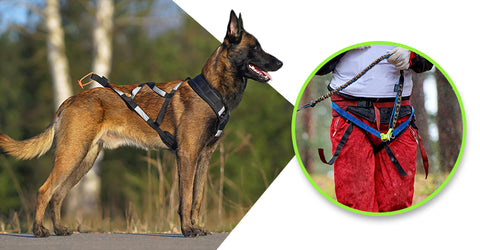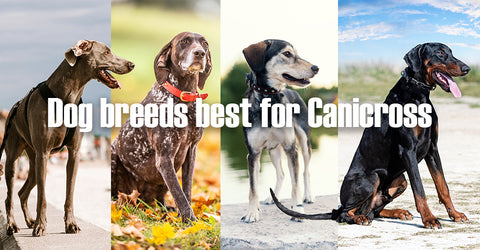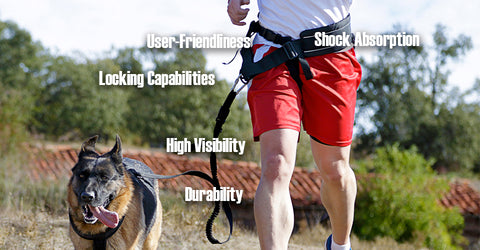
The latest dog fitness trend is gaining momentum for its unique twist on taking a run with your pup. This activity isn't for the faint of heart, but it is a great way to get a workout while challenging yourself as you and your dog work together. But, what is Canicross, and how can you get started?
Canicross is a combination of the words "canine" and "cross-country." It's like going on a challenging run with your dog on hiking trails, so practice and safety skills are needed to thoroughly enjoy this sport. The dog wears a harness specifically made for Canicross, and the person is attached to the harness with an elastic line and a waist belt. The equipment makes the sport hands-free because there's no leash to hold onto: it's all in the waist.

Because you run hands-free, it offers more balance when running on uneven ground. Plus, if you and your dog stumble or trip, you're more likely to stop yourself from falling. You can also protect yourself from branches, and you'll be able to better pick up after your dog or apply medical aid if you or your dog gets scratched up.
It got its start in Europe as a way to train sled dogs in the off-season and keep them in shape. Then, it evolved into its own sport with Canicross competitions beginning in the early 2000s. Today, Canicross has attracted competitors and dog enthusiasts of all levels.
Some competitors say that running Canicross makes them feel more balanced when running because they're hands-free. When the runner's feet are off the ground and the dog gently pulls them forward, they describe it as "feeling like flying."

Canicross is still mostly unheard of in the United States, or it goes by a different name like "caniXC" or "caniX." However, the sport is breaking through in colder climates where sled dogs and mushing activities are more common, like Alaska, Colorado, Minnesota, Michigan, Wisconsin, Montana, Wyoming, Oregon, Massachusetts, Vermont, New Hampshire, Maryland, New York, and Maine.
The only equipment needed is a proper Canicross harness made to withstand the dog pulling the runner forward, a six to ten-foot elastic line that attaches to the harness, and a runner's waist belt.

Although some runners may claim that only certain dog breeds are allowed to run in competitions, this isn't necessarily true. Every competition may be different, but for the most part, as long as your dog is healthy and able to run long distances, they should be able to participate.
But, certain dogs have a greater chance of keeping up with the rough terrain of these long-distance races. These breeds include the Weimaraner, Dalmatian, Vizsla, German Shorthaired Pointer, Rhodesian Ridgeback, English Springer Spaniel, Doberman Pinscher, American Foxhound, Saluki, and Belgian Malinois, to name a few.

However, you don't have to have any of these breeds to be a successful Canicross competitor. If you have a medium-sized dog that has learned basic training and obedience skills, as long as they are fit and healthy to run long-distance, they'll be great Canicross dogs!
But, your dog will have to learn a few commands for Canicross: "speed up" and "slow down." Because you're running together, you'll need to tell your dog when to slow down or speed up. During a run, you need to be in sync with your dog, so you'll need to listen to each other.
Also, make sure that your dog doesn't get distracted by other dogs or want to chase them. Your dog needs to have a sharp focus to stay on track during your run. Plus, because you're connected to your dog at the waist, you don't want your dog to drag you along with them on a chase!
The only dogs that absolutely should not be running Canicross are smaller dogs like toy breeds, puppies, and senior dogs.
Imagine a chihuahua trying to keep up on an intense hiking trail compared to a medium-sized dog. Although we love all breeds of dogs, we also have to match up every dog's strengths and abilities to make sure our companions don't get injured.

Because puppies' joints are still forming, it's not a good idea to train them on these long-distance runs. Regular, short walks are great exercise for puppies, but they can easily get seriously hurt during Canicross. If you want to train them to run Canicross when they're older, get them used to the harness and waist during your walks. Wait until they've grown into an adult dog to get them fully involved in Canicross: it'll be better for their health.
Senior dogs are at similar risk for injuries, just like puppies. Except their joints, bones, and muscles aren't as strong as they were in their younger years. Also, they aren't going to be able to keep up as well during the long run and can get overtired.
So, where can you run Canicross? Although we've mentioned hiking trails, you can participate in Canicross anywhere you can run! The woods, the beach, the park, the possibilities are endless.
The point of Canicross is to be in nature with your dog as you both become more in sync with each other, so cut out the city noise and venture into the wild.
However, with every location you decide to run in, make sure you stay safe. Make sure you bring your cell phone, first aid kit, and other supplies if you get injured or have another emergency.
But where can you find Canicross races in your area? Search online for dog races nearby, look for Canicross chapters in the U.S., or look into organizing your own Canicross group and conducting races.
Canicross equipment is a quick online search away, so even if you can't find a race or group nearby, you can at least start training with your dog! When browsing for your own Canicross gear, also called "hands-free leashes," there are several features to look out for to ensure the best fit.

Locking Capabilities: On a hands-free leash, one of the top features is its locking capability between the waist belt and the elastic leash that also connects to the dog's harness. You wouldn't want the leash to snap off in the middle of a run, mainly because it could cause serious injury if it whips out at you or your dog. So, make sure the leash clips securely to the waist belt and the harness.
If you're looking online, check out the photos or videos of the product and look for durable, secure metal snap clips or hooks on the gear. Never buy a hands-free leash with plastic snaps: they are sure to break.
User-Friendliness: You don't want to order a hands-free leash without researching it first. What if you get it in the mail and become overwhelmed with its mechanisms? Plus, everyone has a different waist measurement and preference for simplicity or something with all the bells and whistles. So, depending on how simple or complex you like your fitness equipment, ensure that you get a hands-free leash that you know how to adjust.
Shock Absorption: An injury from tripping or falling during a run isn't the only possibility of getting hurt. If your waist belt doesn't have proper shock absorption, this could result in a sore lower back. Because you're utilizing the muscles in your lower body, the belt needs to be lightweight, comfortable, and adjusted correctly.
Look for bungee material in the belt's construction: bungee will stretch enough so your dog can gently pull you with them without putting all of the physical strain on your lower back. Also, look for padding or lining within the waistline of the belt to give your back extra support and comfort.
High Visibility: When you're running, you should have a reflective strip on your waist belt so anyone in the area can easily see you and your dog running in low-light conditions. Even if you're running in a wooded area or anywhere that appears secluded, it's still a good idea to play it safe. Or, make sure you get a waist belt and dog harness that offer a range of bright colors like orange, yellow, or red, so you and your dog can be seen easily in nature.
Durability: You'll want a hands-free leash that holds up to your toughest Canicross training! You don't want a waist belt and harness to weaken quickly, so check for high-quality construction. When checking out belts, look for other durable materials like wear-resistant nylon and weatherproof material.
The only other equipment needed is a small backpack to carry your cell phone, a first aid kit, snacks, and water for you and your dog. You want to pack light so you don't weigh yourself down, so only bring the essentials with you for Canicross. Think small water bottles and a travel-friendly dog bowl that can fit conveniently into your pack.

Canicross is a fun and physically challenging activity for people and dogs alike. It encourages teamwork, strengthens the bond between you and your dog, and gives both of you a healthy workout. So, follow the tips above to get started in this growing trend and meet other Canicross lovers!




1 comment
Well-bred and healthy Chihuahuas, as well as other toy breeds, are more than capable of running canicross with you. While they won’t be pulling as much, they will be flying across the trails. If introduced properly, they love running just as much as any other dog and are often much faster than their handler.
Toy breeds are dogs, and they enjoy being active just as much as herding and hunting breeds. Non-Stop offers proper Freemotion trekking harnesses that fit my 3 kg Chihuahua like a glove. He runs with me for an hour and doesn’t seem bothered at all.